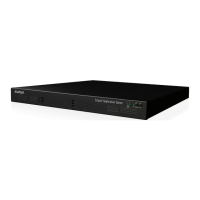There are two Scopia
®
SR Manager portals:
• Scopia
®
SR Manager Administrator Portal: Administrators use this portal to perform the
following tasks:
- Configure and manage video communications devices
- Manipulate content
- Monitor user roles
- Create and set global policies
- Identify best practices and usage effectiveness through comprehensive reporting
- Allow access to the VDN for CDN deployment or programs
- Manage organizations, in a multi-tenant deployment (including what profiles, categories and
CDN settings they can access)
- Create and manage viewer mappings to associate viewers with the appropriate distribution
node location
• Scopia
®
SR Manager Viewer Portal: Viewers select the Recordings and Events tab on the
main Avaya Scopia
®
Desktop page to access the viewer portal. Viewers can perform the
following tasks:
- View programs
- Navigate categories
- View live or on-demand programs
Related Links
Example of a direct DMZ deployment on page 8
Example of a reverse proxy deployment on page 10
Example of a distributed deployment on page 11
Example of a cloud deployment on page 14
Scalability on page 15
System requirements on page 16
Example of a direct DMZ deployment
Figure 1: Direct DMZ Deployment on page 9 displays an example of a Scopia
®
SR deployment
that is situated directly in the demilitarized zone (DMZ). The deployment is a centralized or all-in-one
solution, which means that all of the Scopia
®
SR components reside on a single server. An all-in-
one solution is suitable for a small or medium deployment that does not require redundancy.
Introducing Avaya Scopia
®
Streaming and Recording
8 Installing the Avaya Scopia
®
Streaming and Recording Server June 2015
Comments on this document? infodev@avaya.com

